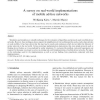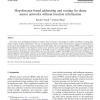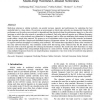ADHOC
2007
13 years 11 months ago
2007
— The problem of congestion in sensor networks is significantly different from conventional ad-hoc networks and has not been studied to any great extent thus far. In this paper,...
ADHOC
2007
13 years 11 months ago
2007
In the past five years Bluetooth scatternets were one of the most promising wireless networking technologies for ad hoc networking. In such networks, mobility together with the f...
ADHOC
2007
13 years 11 months ago
2007
Abstract. Many ad hoc routing algorithms rely on broadcast flooding for location discovery or, more generally, for secure routing applications. Flooding is a robust algorithm but ...
ADHOC
2007
13 years 11 months ago
2007
We present a clustering technique addressing redundancy for bounded-distance clusters, which means being able to determine the minimum number of cluster-heads per node, and the ma...
ADHOC
2007
13 years 11 months ago
2007
Simulation and emulation are valuable techniques for the evaluation of algorithms and protocols used in mobile ad-hoc networks. However, these techniques always require the simpli...
ADHOC
2007
13 years 11 months ago
2007
We present a self-healing On-demand Geographic Path Routing Protocol (OGPR) for mobile ad-hoc networks. OGPR is an efficient, stateless, and scalable routing protocol that inherit...
ADHOC
2007
13 years 11 months ago
2007
ADHOC
2007
13 years 11 months ago
2007
One of the most challenging problems in wireless sensor networks is the design of scalable and efficient routing algorithms without location information. The use of specialized ha...
ADHOC
2007
13 years 11 months ago
2007
In this paper, we derive the information theoretic capacity of a special class of mesh networks. A mesh network is a heterogeneous wireless network in which the transmission among...
ADHOC
2007
13 years 11 months ago
2007
Multi-hop relaying in cellular networks can greatly increase capacity and performance by exploiting the best available links to a base station. We envision an environment in which...




